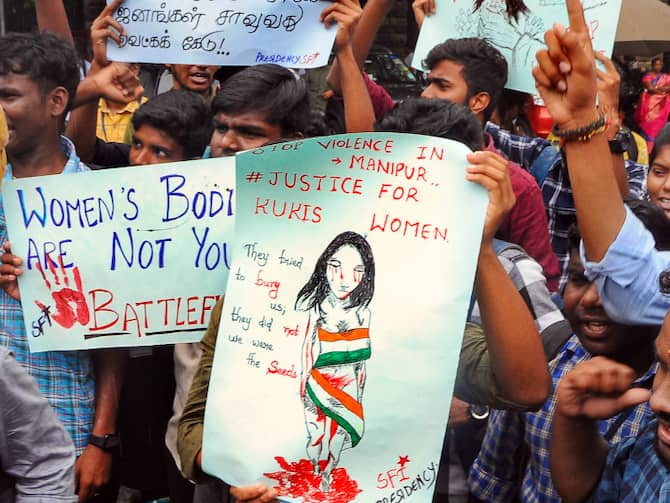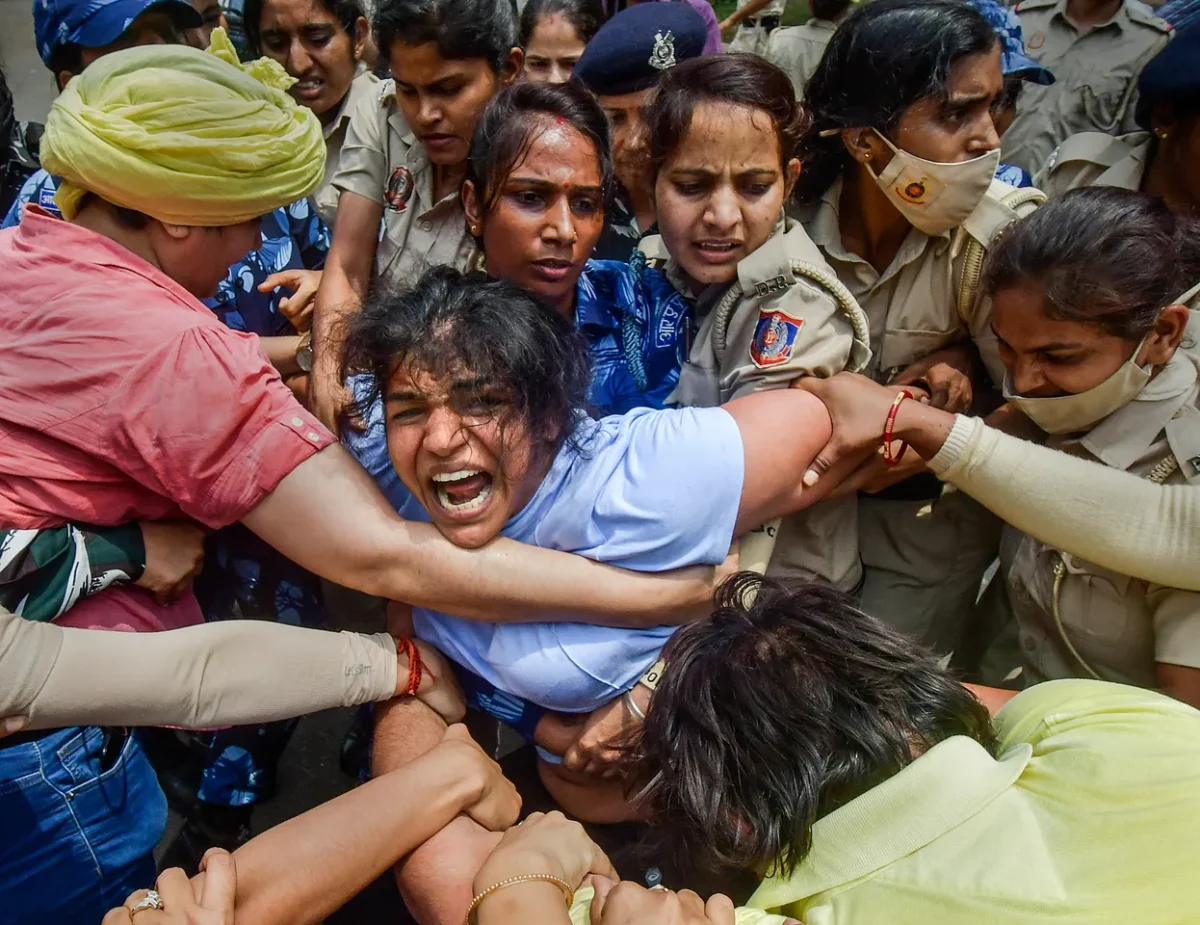India Tops In Migrating to OECD Nations: Indians Renouncing Indian Citizenship And Migrating Abroad Can Be A Sign Of Compromising Society!
According to the OECD's International Migration Outlook: 2023 report, which was released on this Monday, 407,000 Indians migrated to OECD countries in 2021. It was 86% more than 220,000 Indians in 2020.

Imagine you are a small child and desire to eat a cake. Now, your mom said that if you do a certain task honestly and hardworkingly, you will get a full cake. You, being very enthusiastic about getting the full cake, does the entire job. And when you get the cake, the return of your hard work, suddenly your relatives arrive at home and start taking pieces of your cake, which is supposed to be hard work of your action only. And at last, you are left with only one slice of the cake. Imagine how bad and frustrated you will feel.
This is the situation of the common man in India. They did their hard work and got their salary, and when it comes to taking the privilege of their hard work, these ridiculous taxes come on their way and snatch away a major portion of their hard work and leave them with frustration and sadness.
What will you do in the former case? Of course, when you start earning enough money, you will leave your home and go away from these nasty relatives. Relatively, people who are earning great, aka our High Networth Individuals(HNIs), are leaving their homeland, renouncing their Indian citizenships and moving to a better place where nobody will take their hard-earned money in the form of nasty taxes!
A growing number of Indians are choosing to surrender their passports and renounce their citizenship. In July, the Central Government informed Parliament that over 15 lakh Indians had given up their citizenship in the previous decade, with the majority going to the United States of America. While the Ministry of External Affairs (MEA) claimed that many are taking up foreign citizenship to explore the global workplace and for “personal convenience,” the ‘great Indian migration‘ is primarily thought to be the result of a search for better economic opportunities, improved social security, and, of course, to avoid paying large amounts of tax in India that will wash away their hard-earned money.
Here’s a bit of a display of numbers showing the migration of Indians in the last decade.
- Over 87,000 Indians renounced their citizenship in 2023.
- 2,25,620 in 2022.
- 1,63,370 in 2021.
- 85,256 in 2020.
- 1,44,017 in 2019.
- 1,34,561 in 2018.
- 1,33,049 in 2017.
- 1,41,603 in 2016.
- 1,31,489 in 2015.
- 1,29,328 in 2014.
- 1,31,405 in 2013.
- 1,20,923 in 2012.
- 1,22,819 in 2011.
Why are Indians renouncing their citizenship in such huge numbers? What do the figures indicate?
In India, migration is not a new phenomenon. Industrialisation and subsequent colonialism by the British spurred a large mobilisation of Indian agrarian populations over a wide range of geographical areas. From 1834-1937, an estimated 30 million Indian migrants moved to the British Empire’s foreign territories, according to historian Rana P. Behal in a thesis on Indian migrant labour.
In 2021, India remained the top country of origin for new immigrants to the Organization for Economic Cooperation and Development (OECD) nations. According to the OECD’s International Migration Outlook: 2023 report, which was released on this Monday, 407,000 Indians migrated to OECD countries in 2021. It was 86% more than 220,000 Indians in 2020.
The OECD is a club of 38 countries, the majority of which are high-income and have a high Human Development Index (HDI). Among those Indians who moved to OECD countries, 133,000 were granted nationality, the largest number among all countries. These acquisitions were largely made in the United States of America (56,000), Australia (24,000), and Canada (21,000).
One of the primary reasons is the Exhaustive tax structure.
One of the obvious answers for renouncing Indian Citizenship is the exhaustive taxation in India. Don’t go very far into history or any complicated government data. Just go to a supermarket, have a month of shopping, and see the bill. The bill is filled with numerous charges that are taken in the name of taxes. If you want to learn more, ride on a journey between two distant places by car and see the various taxes collected in the name of road tax, toll tax, etc. The toll tax range was increased between 10% and 15% in 2022, raising the tariff charges of all sorts of cars travelling on national highways by Rs 10 to Rs 60.

These are just a few examples; if you want to learn more about various taxes in India, go to any prominent finance content page, and you will get a full-fledged blog on various taxations In India.
The next one can be in search of Better Education facilities.
China (885,000), India (424,000), and Vietnam (133,000) are the top three countries of origin for overseas students in OECD countries. Furthermore, the number of Indian students has more than doubled since 2014. On one hand
During his speech at the Rozgar Mela, Prime Minister Narendra Modi reminded the audience that his government had constructed IITs and IIMs in the nation every year between 2014 and 2022. He went on to say that throughout the nine years of the Bhartiya Janta Party’s control, his administration worked to modernise the nation’s educational system by founding several Indian universities.
However, the intent of Indian students moving abroad shows the status of colleges and universities in India. There are a plethora of Engineering colleges which have the same old syllabus that was used 5 years ago. More than that, there are multiple MBA colleges where VAT and application of 3% cess is a part of the syllabus, whereas in reality, VAT is no longer a part of our system, and now we are working on 4% cess. So, if you’re wondering if IIT is one of the top 100 colleges in the world, the answer is absolutely NO.
The annual QS World University Rankings 2024 list was announced by Quacquarelli Symonds (QS), and no Indian university made the top 100. The first in the country is IIT Bombay, which is placed 149th. It is followed by IIT Delhi, which is placed 197th.

While some of these socioeconomic causes are relevant to the Indian context, the Union government asserts that many Indians choose foreign citizenship to “explore the global workplace and for reasons of personal convenience.” This can sound good at once, but if you think from the other side of the table, why ‘personal convenience’ is more convenient in foreign lands than on Indian soil? There are various factors why people are taking a jibe at the cultures of Indian society and making efforts to settle foreign territories.
Another can be the lethargic judicial system of India.
According to a 2016 article, more than 22 million cases were waiting in India’s district courts at the time. Six million have lasted more than five years. Another 4.5 million are awaiting hearings in the high courts, with over 60,000 in the Supreme Court. Leave that, Tirath Singh Thakur, India’s then-chief justice, broke down in front of PM Mr Modi, lamenting government inactivity on judicial delays, particularly the failure to recruit enough judges to cope with the massive backlog of pending cases. The law ministry received only 0.2% of the overall budget in the 2016 government budget, one of the lowest levels in the world. How can such an important ministry get such a small part of the budget?
However, the number of cases is simply one aspect of the problem. Take a walk through any courthouse in India, and you’ll witness lengthy lines of people waiting outside courtrooms with no promise of a full hearing. According to a February 2023 article, India has about 21 judges per million people, considering the sanctioned strength of the judiciary and census numbers from 2011, compared to 50 in wealthy countries. As a result, India does not have good judge-to-population ratios in the world. To add to the burden, lawyers frequently use delaying techniques such as constantly appealing rulings, claiming illness, or forgetting to appear in court.

“The progress of this country is dependent on a strong judicial system that can provide quick justice in commercial matters,” says Dushyant Dave, a senior advocate in the Supreme Court who believes the judicial system has deteriorated since he began practising in 1978. The legal logjam has resulted in overcrowded jails, with more than 68% of the prison population remaining on remand in 2016. Some prisons are more than two or three times full. Bail is frequently granted based on the calibre of a defendant’s counsel.
For instance, even if you don’t understand the statistics running behind this, just connect these lethargic judicial systems with famous cases, and you will know what is the condition of Indian law and the Indian judicial system. For instance, recall the famous Johnny Depp and Amber Heard’s case. There were several memes floating around the internet at that time that if such a case had been trialled in Indian courts, justice would have taken a long journey to find its destination.
Another article from 2016 published in a famous Gulf newspaper titled “India justice system: simple clerical errors add to frustrating wait” drafts how Major Manjit Rajain had to skip a day of work every month for a long nine years over a case against him, which was eventually dismissed as a clerical error. After he retired from the army and launched his first business, the ROC filed a suit against him for misrepresenting himself because the army files showed his surname to be Rajan, without the i, and he had mentioned his surname Rajain, with an ‘i’ on the forms to register his company.
Major Rajain clarified how insignificant the mistake was. Even though the ex-soldier produced numerous documents to the court, including his passport, birth certificate, marriage certificate, and other proof that his last name contained a “i,” the lawsuit against him was not dropped for nine years. Imagine a respected soldier who had honestly and proudly served in the army had to face such a nuisance just because of mere error, and the Indian judiciary has dragged the soldier into court for nine straight years. That’s the pathetic condition of the Indian judiciary, so why will people not leave India and desire to set their lives in nations and lead a peaceful life?
Who wants their kids to grow up listening to the news of religious violence every now and then? The next reason is religious violence.
An August 2023 event depicts how religious violence reaches India’s capital as a Hindu mob swarms a church. According to the church’s pastor, Satpal Bhati, a gang of roughly 30 people attacked scores of churchgoers, including women and children. The Aug. 20 attack on a Protestant church in northeastern Delhi occurred less than 10 miles from where foreign leaders, including President Joe Biden, were scheduled to meet in September for the Group of 20 economies’ annual summit.
“The attackers came straight inside and started beating up people. They broke a chair, tore the Bible, busted the drums, and beat the kid’s hand, who was playing the drum with a rod and said, This can’t go on, you can’t do this, this is a Hindu nation‘.

Communal violence is not new in India, a Hindu-majority country of 1.4 billion people, where confrontations have occurred on a regular basis since the Indian subcontinent was partitioned by its departing British colonial masters in 1947. However, there has been an increase in attacks on Muslims, who account for approximately 14% of the population, as well as Christians, India’s second-largest religious minority, accounting for less than 3% of the population.
Religious divisiveness, according to critics, has worsened under PM Mr Modi and his Hindu-nationalist government. Thousands of Muslims fled violence-stricken slums in the adjacent state of Haryana a few weeks before the church attack in Delhi after seven people were killed during a religious Hindu parade organised by groups ideologically linked with Modi’s Bharatiya Janata Party. Muslim stores and homes were attacked as communal riots extended from the Nuh neighbourhood to Gurugram, a tech hotspot home to global corporations including Google, Ernst & Young, and Deloitte.
The recent Manipur violence is another example of how deeply ethnic violence is ingrained into the minds of our people that we forget humanity while dealing with this. During a June visit to the White House, Modi denied that India faced bias due to religion, claiming there was “absolutely no space for discrimination” in his government. Since then, he has faced criticism for his handling of violent riots between Hindu and Christian ethnic groups in the northeastern state of Manipur, which he kept quiet about for more than two months until a video of two women being compromised went viral.

Again, a news item from June 2023 highlights communal strife in Uttarakhand, where Muslim shopkeepers were warned to “leave before Hindu Mahapanchayat or face consequences.” A few days after CM Dhami urged the Uttarakhand Police to take strict action against reported incidences of ‘Love Jihad,’ posters were placed in front of Muslim business owners’ doors, ordering them to vacate their premises by June 15, ahead of a scheduled Mahapanchyat called by Hindu organisations.
To imagine this scene, recall the famous movie ‘Kedarnath’ of the talented actor Late Mr Sushant Singh Rajput, where the character he was playing, a Muslim Boy Mansoor, was told not to interfere when Hindus were speaking, and the narration was ‘Aur Tum Kahase Aagaye Humare Bich?’.

Again, the case of the late actor, which started in 2020 after his alleged suicide, is still sub-judice and displays how slow our judiciary can be!
Another major factor is the safety of women and children.
According to a 2020 research by the Global Wealth Migration Review, over 7,000 wealthy Indians, high net worth people (HNIs) with wealth of more than $1 million or 8.2 crore, dropped away their citizenship in 2019. The report says common reasons HNIs move include the safety of women and children as one of the prominent reasons.
This segment needs no more clarification; just recall the case of Jantar Mantar, where our respected athletes have protested for months against the head of the Wrestler Federation with the charges of sexual assault, but no importance is given to their pleas. Even after months, no arrests were made to punish the person in the crime. If this is the condition with powerful and famous athletes, imagine what could be the condition of a common woman in India.

Another example is the event where the Samajwadi Party (SP) chief Mulayam Singh Yadav said rapists should not be handed over the death penalty for their ‘mistakes’ by mentioning that “Rape ke liye phaansi dena ghalat hai, ladkon se ghalti ho jaati hai, hum satta mein aaye to kanoon mein badlav karenge”!Hearing this statement, I think we neeed to redefine our punchline from “Beti Bachao, Beti Padhao” To “Samaj ko bachao aur sabko sahi-galat ka path pathao”.
Conclusion.
And the number of many other factors work behind the leaving of Indians from India, specifically the HNIs. How much we say that we are heading towards a global leader with brilliant growth in GDP, if the government cannot make their citizens feel safe and privileged inside the nation, this act of migration will eventually increase in the upcoming years, resulting in talent and financial drain from the nation.
So by implementing and executing strict laws, making an energetic judicial system, providing a safe environment for everyone in the nation and reducing the tax imposed on the common man, the government can ensure that their people are happy and hence actively contributing towards the development of the nation.




